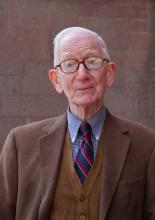A Message from the Author - Andrew Hacker '51

Most of my books have been quite sweeping in scope, dealing with race and sex and wealth, not to mention the fate of the American nation. But a few years ago, my domestic partner Claudia Dreifus, suggested that I descend from my Olympian perch and look at my own backyard: the academic world, which I’ve inhabited all of my adult life. I agreed; but on the condition that we write it together. She’s an award-winning journalist, and would ensure that the book would focus on real people. That’s how Higher Education? got started.
The best way to give a taste of what we’ve done is to cite some of our chapter headings, which convey much of what we say.
In real dollars, tuition charges have tripled in the last generation, more than any purchase Americans are called upon to make. Why College Costs So Much explains why. One cause is proliferating bureaucracies (“director of “collaborative engagement,” “coordinator of learning immersion experiences”). Another is an amenities arms race (five-story climbing walls, orange-ginger tofu steak for dinner). In these and other cases, it’s students who pay, with two-thirds now graduating in debt.
College sports entertain close to 100 million spectators each year, with many more watching on the tube. Yet of the 629 football teams, only 14 cover their costs. The Athletics Incubus shows how even low-profile teams skew campus priorities. The University of Texas spends $56,859 on each of its volley ball players, leaving less money for classroom instruction.
Even at liberal arts colleges, promotions now call for research, not dedicated teaching. Almost a third of the Williams faculty is on sabbaticals in a typical year. The Professoriate wonders how much of what they publish is really needed. In a recent 14-year period, academics churned out 2,791 papers on William Faulkner. Their real purpose: to bulk up résumés.
Medical care is supposed to enhance a nation’s health. And higher education? In The College Crucible: Add Students and Stir, we ask how those classroom-campus years actually affect individuals. In fact, holders of bachelors’ degrees do differ from their high school counterparts. But not in ways colleges would like you to believe.
As should be evident, we’re not pleased with many of the turns higher education has been taking. Too much of it isn’t higher; much isn’t even education. (We don’t count fashion merchandising or resort management as liberal arts.) But in our travels, we came across several Schools We Like. We explain why Arizona State University and Notre Dame, and Evergreen State College and Raritan Valley Community College, do better by their students than many institutions with prestige names.